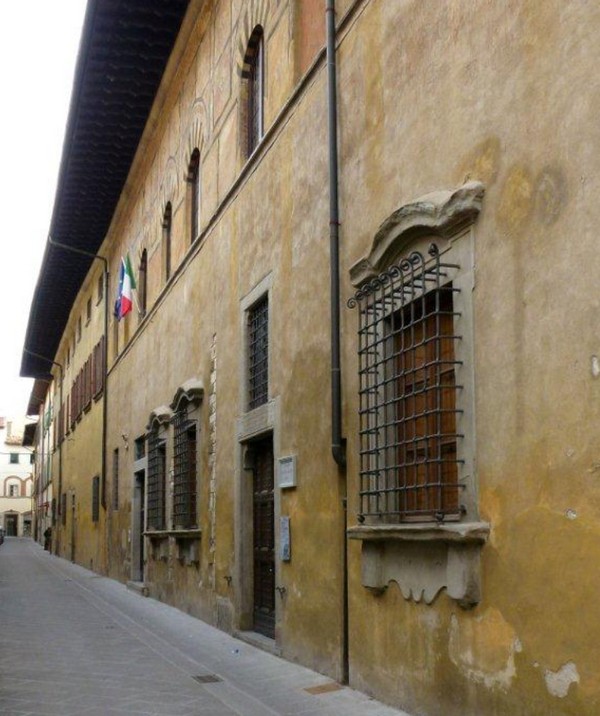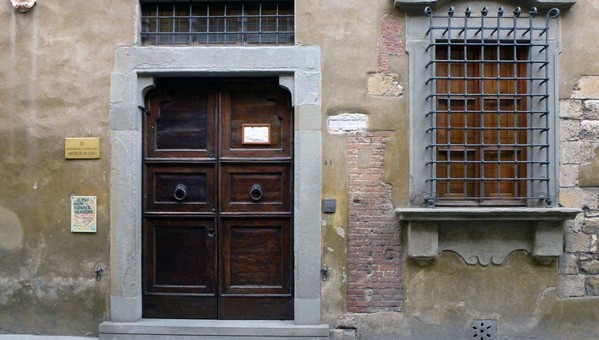Introduction
This note can be seen as a further contribution to the early history of playing cards around Florence. However, the location is now in another town, Prato, where the conditions of card trading could be rather different, at least in principle.
I had already visited the Archivio di Stato di Prato (ASPo) more than twenty years ago, because there is located the very interesting Archivio Datini. Who Francesco Datini was can be found in every encyclopaedia, but in this case he is of interest only because the ASPo is directly located in his own mansion.(1)
The Misericordia and Dolce Hospital
As a Estranei section exists in Archivio dell’Ospedale degli Innocenti, in Florence, something similar can be found within the ASPo, in the archive of the Ospedale Misericordia e Dolce.(2) Even though its section Famiglie e Persone is remarkably smaller, it has been studied and considered one of the most important in Europe for its documents on retail trade, especially thanks to several account books of the 14th century – a whole book has been published with a research on these documents.(3)
Ser Andrea di Giovanni Bertelli
I had never found among mercers or similar retailers a famous personage as Ser Andrea Bertelli was at the time. First of all, he could avail himself of the Ser designation, typical of the notaries. We can find information more than enough about him as a notary and a public man. To begin with, he is present in historical works on Prato citizens,(4) and in a dissertation on the notaries of the town.(5)
Unfortunately, we know much less him as a retailer, even if his activity in various enterprises is known. In the same ASPo we can find books (in about 1430 and 1440) in which he is camarlingo notaio of the Ospedale Misericordia; in other books he holds, with various colleagues, the concession by Comune di Prato of Gabella, either of bestie, animals (1428), or of "grano e biada", wheat and crops (1432), or of wine (1440).
His many official public charges are listed for instance in the dissertation on Prato notaries, (5) including several leading roles he had in the town government. In conclusion, his activity of retailer that is the reason why we meet him here may be considered just as a minor one among his many offices and professions.
The shop
Whenever I enter one of these shops of the time, I feel a big difficulty in finding the right name for it. Of course, to a great extent this is due to the fact that English is not my mother tongue and moreover I did not have the opportunity to get familiar enough with the corresponding shops in Great Britain. Frankly speaking, however, I have to add that even in my mother tongue I have some difficulty in finding the correct name for them.
Let us thus make use of a direct information, what Ser Andrea inserted in the Catasto books of 1451.(6) "Una botegha (per la vendita?) di biada e di pizzichagnolj. In tutto dà detto traffico fiorini cinquanta." Here we mainly have a pizzicagnolo, maybe a grocer. It seems that the shop in question was that of his father-in-law: ser Andrea became his partner in the trade and then continued this activity, together with his wife Antonia.
In this shop, people acquired first of all foodstuffs of many kinds. We read of wheat meal, barley, broad beans, and as expected olive oil and wine, but always in small quantities.
Together we find however many small items and household goods, such as candles and pins. Playing cards themselves, which might appear out of place here, are not alone in the family of games and toys: balls of various kinds, spinning-tops, dice and board games were also on sale.
The account books
No less than seven account books are kept for the shop under examination.(7) The two most important for us are those numbered as 7007 and 7008. They are very similar and seem to have been compiled one after another, mainly for 1429 the former (10 July-8 December), and 1430 the latter (11 May-24 October).
The various entries are recorded daily (even on Sundays!) with such a detail that I had never seen before, down to recording a couple of eggs or an iron wire. Indeed, this corresponds to the titles of the books, especially the former ("Quaderno di entrate di denari minuti", register of little money incomes.) The latter book is titled differently "Giornale di botega, ciò che venderemo biade e altre chose", but its format is exactly the same.
A third book has been helpful, numbered 7006 and titled Conpere, purchases.
Unfortunately, the writing is not easy to read, and - what has confused me the most - sometimes I have not been able even to distinguish with certainty number 1 from number 2, which may be relevant below either for the number of card packs, or especially for their prices. Even though our information on this trade is small, it deals both with purchases and sales.
Purchases of naibi
I could only find two records of purchases, in book 7006, as summarised in the following Table.
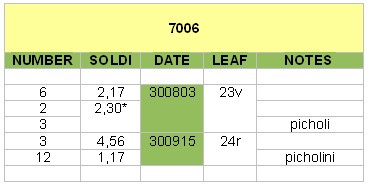
In the course of about two years, we thus have two purchases, which however corresponded to two subsequent months. My impression is that other purchases had been done, and I did not find their records.
We have two purchases of packs of various kinds. The price of 2,30s. is a nominal average price of 5 packs, 2 without any specification and 3 indicated as piccoli, for a total price of 11s.6d.
In the second purchase, no justification is indicated for the higher cost of the 3 packs, possibly grandi or fini.
What is not reported in the table, but may be of some interest, is the indication of the suppliers: they are indicated as two different mercers, both however active in Florence. It was thus from Florence that came the packs to be sold in Prato shop. This provenance is not surprising, due to the extraordinary Florentine activity in every section of handcrafting and painting. (However, we have to remind that, in principle, card playing was forbidden in Florence at the time.)
Sales of naibi
More frequent are the records of packs sold, as summarised in the following table. If I have read the number of the packs correctly, they were sold one at a time, with one exception in which two packs were sold together. This is in agreement with the typical trade of this shop, with retail sales reduced to very small limits for any goods sold. Sometimes naibi are recorded as carte: I have indicated these cases in the table, but I suppose that the two names were here interchanged without any real difference existing in the product. Also for "naibi picholini" and "carte picholine", I think they are both the same as the "naibi piccoli" of other trades.
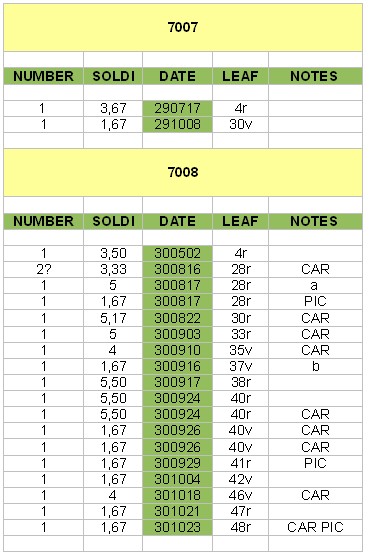
We find 21 packs sold on the whole; only two for 1429, with most of the remaining ones sold in only two months of 1430. These can be compared with the 26 packs that we find as acquired, in two trades only.
I suppose that further trades were made that I have not found. Even if we can imagine that the actual number of packs traded was somewhat higher than reported here, this clearly remains a retail trade, with very small amounts involved.
Conclusion
The information obtained is little, especially in comparison with the many data that I am now collecting in the Florentine AOIF. The amount of cards traded is far from great: it is however possible that the particular shop was not the most suitable for this trade, being mainly a grocery.
This new information is interesting for two reasons at least, its early date and its origin from Prato, where several records of retail trade are kept. At the same time we learn that the cards sold in Prato had been acquired from mercers of Florence.
No indication is provided on the quality of these cards, only in some cases a reduced format is indicated. Mistakes in reading are possible, and the prices are rather scattered, so that even the mark-up cannot be derived with certainty, although it should not be too different from 20 percent, as was common for many goods.(3)
Footnotes:
(1) Prato State Archives
(2) http://www.archivi.beniculturali.it/SAFI/inventari/OspedalePrato.pdf
(3) Richard K. Marshall, The local merchants of Prato. Baltimore 1999.
(4) Enrico Fiumi, Demografia, ecc. Olschki, Firenze 1968.
(5) Francesco Bettarini, Il notariato pratese all’ombra di Firenze (1351-1429), Facoltà di lettere, Università di Firenze, 2003-2004.
(6) ASF, Catasto, 751, 928v.
(7) ASPo, Ospedale, 7004 to 7010.
|
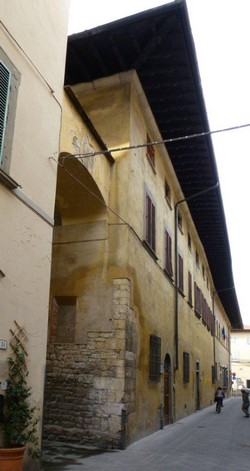
Archivio di Stato di Prato (ASPo)
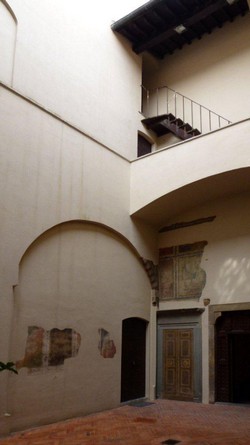
Inside View with fragments of frescoes
"Prato 1429/30" is one of the oldest documents of Italian playing card trade and for the current moment the "oldest" new detection by Franco Pratesi - well, since 4th of November 2011, when this series of articles was started.
It's now Eastern 2012, 5 months later and the 21st new article was written/published and further 10 older articles of Franco are also now available via the web.
The redaction of Trionfi.com is amazed by the quick progress of the work, full of enthusiasm about the research results and grateful for the opportunity to help in the technical realization of the web publication. We think, that this was a period of revolutions in the research of the early Trionfi cards (and likely this phase hasn't ended) - and it's not too much to say, that somehow a new level was reached - the number of very early Trionfi card documents was increased by more than 60 % in the last half year. The collection of the earlier 100 % might have taken about 150-200 years.
It's our hope, that Franco's quick success inspires other researchers with opportunity to visit Italian archives to follow his methods, and that the general research of the object Trionfi cards might gain some more public interest. If researchers are interested to participate in our communicative network, please contact "webmaster(at)trionfi.com"
|
|


